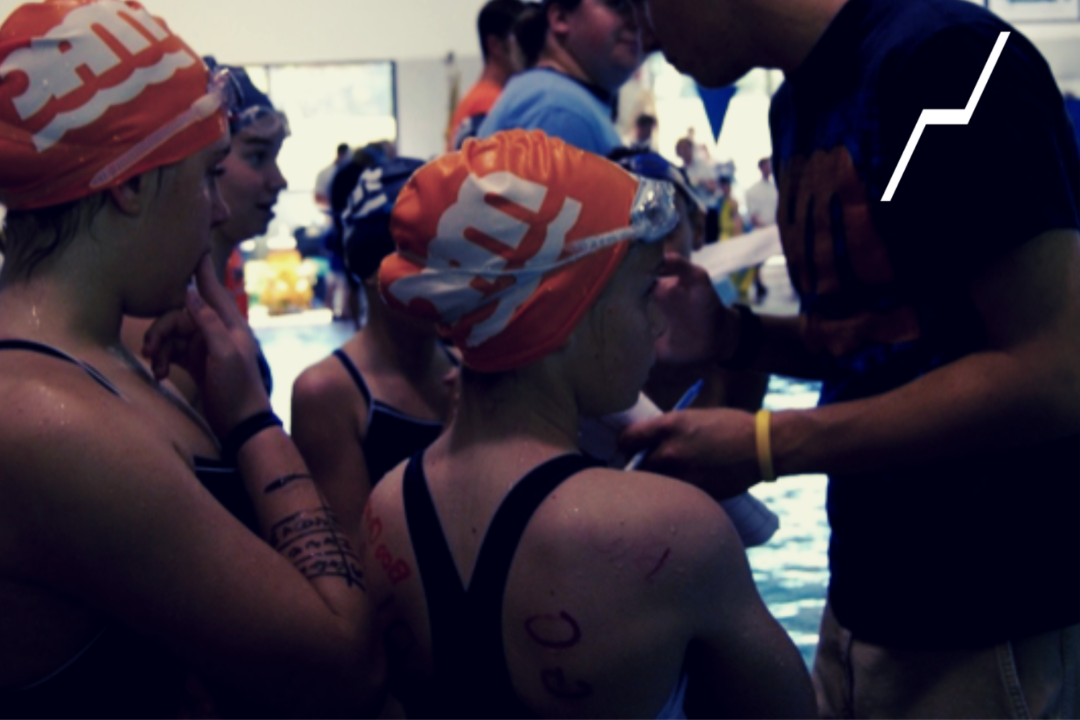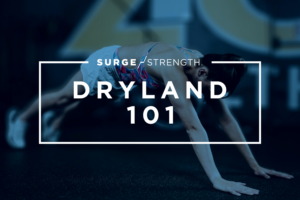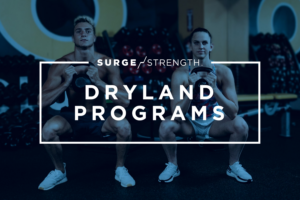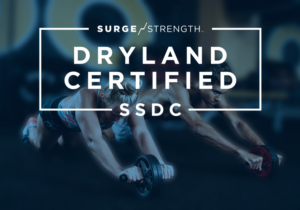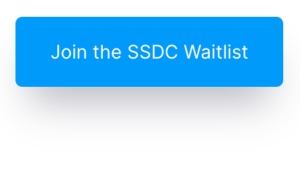A dryland workout for young swimmers, specifically for those who fall into the 10 and under age group, is often regarded as “not needed.” But by the time these swimmers hit middle and high school, there is a large need for a comprehensive dryland program in order to get better. The 10 and under range is the perfect time to build the foundation of movement that swimmers will use for the rest of their athletic careers (and lives). Yet, some swim clubs refrain from dryland and miss out on building this foundation. Some think it’s unsafe—believing the only way to implement dryland is through heavy weight training. Others think it’s a waste of time because 10&unders aren’t mature enough to handle a formal resistance training program. This is largely a myth. SURGE Strength has seen the benefits of 10 and under dryland realized as athletes grow and develop into the peak of their careers. Dryland for 10&unders develops basic movement skills and teaches children to enjoy physical activity when coached appropriately.
1) Safety First in a Dryland Workout for Young Swimmers
Regardless of age, most athletes do not start their dryland journey by maxing out advanced exercises. They learn basic movement patterns and safely progress their training. Therefore, dryland for an athlete who is 10 or younger does not need to look like a traditional strength and conditioning program. Instead, it looks more like an organized recess. The safest measure a coach or parent can take is starting their young athletes at this base level of dryland training. Youth dryland is where kids learn the fundamentals of movement. It teaches kids body awareness and athleticism. Here, they differentiate between safe and unsafe movement patterns. Youth dryland teaches kids to be coachable. If your athletes are more coachable at a younger age, they are less likely to get injured when they are lifting weights as an adolescent.
2) Focus on These Movements in a Dryland Workout for Young Swimmers
At this age, focus on running, crawling, climbing, skipping, and jumping. Our goal for 10 and under swimmers is to train their gross motor skills. Gross motor skills are large, simple movements using our legs, arms, and trunk. When refined, these skills develop coordination, balance, stability, and spatial awareness. Add strength and you have the definition of athleticism. Therefore, our priority is making these movement qualities stronger.
3) Know Your Goals in a Dryland Workout for Young Swimmers
Break down goals at a physiological level. The more physical activity a child participates in, the more motor units they recruit. These motor units are the brain’s way of developing muscle memory through physical activity. In turn, this makes children more athletic. Regardless if the child grows up to be an Olympic swimmer, moves on to other sports, or lands somewhere in-between, these motor units will serve them. Therefore, the primary goal of dryland at this point is to simply increase motor unit firing. Do not feel pressured into skipping this step. It may seem like there are more important concepts to teach young athletes besides playing games. However, these motor units largely determine a swimmer’s potential at the peak of their career.
- Motor unit – a motor neuron and all of the fibers it innervates.

4) Set Up for Success in a Dryland Workout for Young Swimmers
The best way to set up a successful dryland program is to focus on the big picture. Youth athletes have a very small attention span. They do not have the capacity to complete an hour-long exercise regimen. Instead, make it a fun experience. Implement games and situations where kids can tap into the gross motor skills we talked about above. Repeat running, crawling, climbing, skipping, and jumping movements in different, creative ways. This builds both variety and repetition in your dryland plan. Overall, teach the kids that dryland is fun. Steer clear of traditional dryland programming. Otherwise, they may develop feelings of burnout early in their swimming journey.
When working with these young athletes, it’s better to go broad than deep. In other words, implement many different opportunities for them to move without going deep into the mechanics of each exercise. Check out some of our go-to games featured in the SURGE Strength Dryland Certification Curriculum below:
5) Know Who You’re Coaching in a Dryland Workout for Young Swimmers
School-aged children are not “little adults.” They don’t communicate or think the same way. They need a different coaching style. 10&unders do best with outcome-based goals. For example, if you tell them to complete a certain number of broad jumps with a controlled landing, you might get a blank stare or lose their attention completely. Instead, try phasing it like this: “How far can you jump and stick the landing? Let’s do it again and see if we can go further.” This outcome-based cue is much more effective at maintaining their attention. It also helps them understand exactly what you want them to do.
Youth dryland is the first-time many swimmers are asked to complete structured physical activity on land. Most kids will take directions very literally. Keep in mind that they are learning how to follow and take directions. You are training their coach-ability. This is how they learn to understand directions from a coach in an organized setting, aside from repetitive swimming.
In order to keep dryland on task, set boundaries, and guidelines for your activity. Then, keep coaching minimal. Resort to using just one or two quality cues for each movement. Plan your coaching cues ahead of time. Most children at this age do best with visual cues. However, their attention span is limited. Do not overstimulate them with too much cuing and coaching. It is best to let them learn how to move their bodies without too many rules.
Conclusion for a Dryland Workout for Young Swimmers
Coaching 10&unders is a privilege and an honor. You are likely their first dryland coach. They will embed what you teach them as a child and carry it with them into adulthood. You set the stage for how they view physical activity outside of the pool. This is a huge responsibility that shouldn’t be overlooked. Games and simple movements should not be underestimated. Gross motor skills in dryland games and activities build the foundation of athleticism. More importantly, they build a healthy framework for how a child views exercise as adolescents and adults. Youth dryland builds teamwork and buy-in. Kids have an opportunity to interact with one another and the coach. It is an incredible way to build cohesion in an individualized sport. When implemented appropriately, dryland provides youth athletes with many skills that set them up for success for years to come.
ENROLL IN A DRYLAND 101 COURSE FOR FREE
MORE DRYLAND RESOURCES FROM SURGE STRENGTH:
GET STARTED WITH A DRYLAND PROGRAM
LEARN ABOUT BECOMING SSDC

SURGE Strength’s Mission:
BUILD BETTER ATHLETES
GENERATE FASTER SWIMMERS
Courtesy of SwimSwam’s exclusive dryland training partner, SURGE Strength.
SURGE Strength, a strength training brand created by Chris Ritter, CEO of RITTER Sports Performance, aims to build better athletes and faster swimmers through dryland programs and educational courses.
Get started with a SURGE Strength Dryland Program or enroll in a dryland course in the SURGE Strength Academy today!
